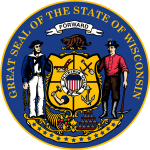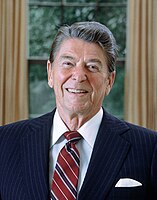| ||||||||||||||||||||||||||
| ||||||||||||||||||||||||||
 County Results
| ||||||||||||||||||||||||||
| ||||||||||||||||||||||||||
| Elections in Wisconsin |
|---|
 |
The 1984 United States presidential election in Wisconsin took place on November 6, 1984. All 50 states and the District of Columbia, were part of the 1984 United States presidential election. State voters chose 11 electors to the Electoral College, which selected the president and vice president of the United States.
Wisconsin was won by incumbent United States President Ronald Reagan of California, who was running against former Vice President Walter Mondale of Minnesota. Reagan ran for a second time with incumbent Vice President and former C.I.A. Director George H. W. Bush of Texas, and Mondale ran with Representative Geraldine Ferraro of New York, the first major party female candidate for the vice presidency. This would be the last time Wisconsin would vote for a Republican in a presidential election until Donald Trump won the state in 2016, and the last time Wisconsin would vote for a Republican with a majority of the vote.[1]
The presidential election of 1984 was a very partisan election for Wisconsin, with over 99 percent of the electorate voting only either Democratic or Republican, though eight additional parties appeared on the ballot.[2] Reagan carried a majority in most of Wisconsin's counties, whereas Mondale carried a majority in ten, mostly in the far northwest of the state, along the Lake Superior coast and across from Minnesota's Iron Range, along with Milwaukee County, Dane County, Kenosha County, and almost entirely Native American Menominee County. Two relatively geographically isolated rural counties--Pepin County in west-central Wisconsin and Portage County in central Wisconsin—rounded out the list; these were Mondale's two weakest wins. One county, Polk County in the northwest, gave neither nominee a majority, but gave Reagan a plurality.
Reagan posted strong wins along the whole of eastern Wisconsin, apart from Manitowoc, Sheboygan, and Racine Counties, and the two Mondale wins in Milwaukee and Kenosha. He posted a particularly strong win in suburban Waukesha County, which he won by over thirty points. In western Wisconsin, Reagan won most of the counties but his margins tended to be weaker. As of the 2024 presidential election[update], this is the last election in which Eau Claire County, La Crosse County, Rock County, and Iowa County voted for a Republican presidential candidate, as well as the last election in which a Republican candidate won more than 40% of the vote in either Dane County or Milwaukee County, both of which have voted Democratic in increasingly large margins since.[1]
Reagan won the election in Wisconsin by a 9-point margin. While a sound victory, this made Wisconsin 9.1% more Democratic than the nation, signaling the consolidation of a new Democratic base in the Upper Midwest.[3] Before 1976, Wisconsin had tended to lean Republican in close elections, voting narrowly for Nixon in 1960 and 1968. In 1976, it narrowly, but surprisingly,[4] voted for Carter. Four years later, Wisconsin would become one of only ten states to back Michael Dukakis, the first time since 1848 it backed a losing Democrat, with it also being the first election since 1960 where it would back the overall losing candidate too.
Reagan was the last Republican candidate to win Wisconsin twice until Donald Trump did so in 2016 and 2024. He also remains the last Republican candidate to win the state in two consecutive elections.
- ^ a b Sullivan, Robert David; ‘How the Red and Blue Map Evolved Over the Past Century’; America Magazine in The National Catholic Review; June 29, 2016
- ^ "1984 Presidential General Election Results – Wisconsin". Dave Leip’s U.S. Election Atlas. Retrieved November 11, 2013.
- ^ "CQ Almanac Online Edition". library.cqpress.com. Retrieved December 31, 2020.
- ^ "CQ Almanac Online Edition". library.cqpress.com. Retrieved December 31, 2020.


